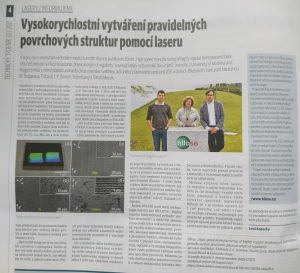
14th November 2017 Technical Weekly, Prague.
This Tuesday 14th of November 2017, several articles were published in the media of Czech Republic on our research findings.
- An interview of Prof. N. M. Bulgakova and Dr. T. Derrien has been published in Technical Weekly on the 14th of November 2017. This public review aims to inform citizens of Czech Republic on the latest public news about research and technology. It is mostly read by people from research and industry. A snapshot of the printed article is provided. The website only provides the first sentences of the article.
- The same interview has also generated a second full length article (in Czech) available on the website of Czech Television (Ceska Televize), the most important public funded channel in the Czech Republic. The Google Translation though reveals some inaccuracies, which could emerge from the automatic translation. As we didn’t get the chance to authorize the final version of the article, a list of inaccuracies is provided below.
- The news was also republished by Novinky.cz, 7th-8th most visited website in the Czech Republic (according to Alexa).
- Finally HiLASE also republished the article in Czech (link to the article) on the laboratory web page.
List of mistakes identified in the article of Czech Television.
- The original discovery of the large area processing at such level of regularity was demonstrated by the group of Jan Siegel and Javier Solis in CSIC Madrid, Spain (Optics Letters 2014). The limit of this study was found in the treated material: only Chromium could exhibit regular structures in the regime of removing matter with laser (named “ablation regime”).
- The novelty of our study lies in the theoretical model, which predicts the possibility to obtain high regularity on a large amount of metals as the experimentally observed regularity was successfully correlated with the distance on which some surface electromagnetic waves travel at the surface of the laser-irradiated metal.
- The contribution from our italian colleagues is found in the realization of the series of experiments performed on 6 metals, which support the theoretical analysis and theoretical predictions.
- The head of HiLASE is Dr. Tomas Mocek (see the page of staff on HiLASE website). Note that this mistake was introduced by Google Translate, and not by the authors.
Leave a Response